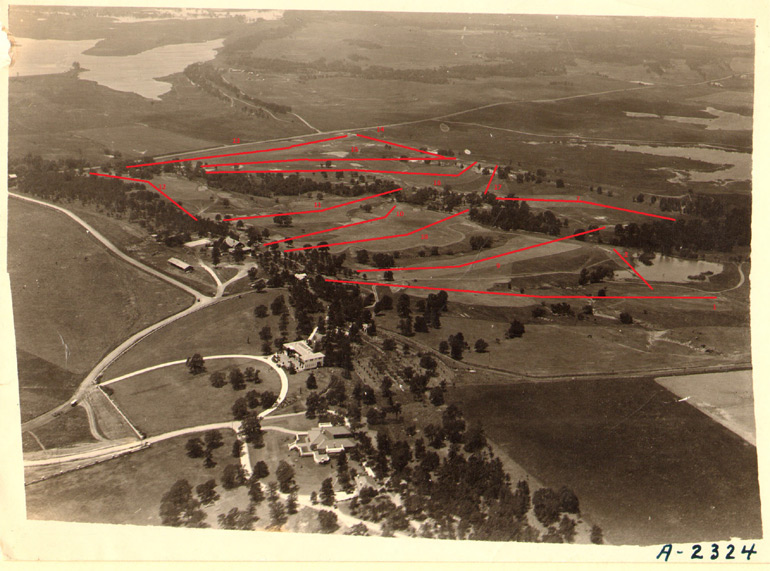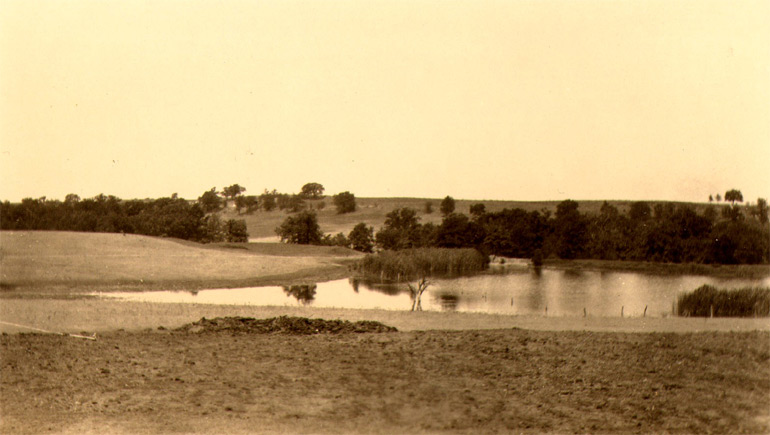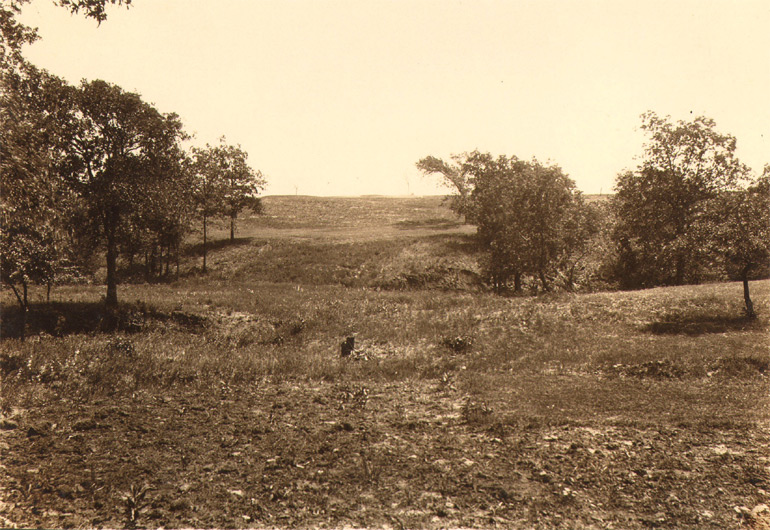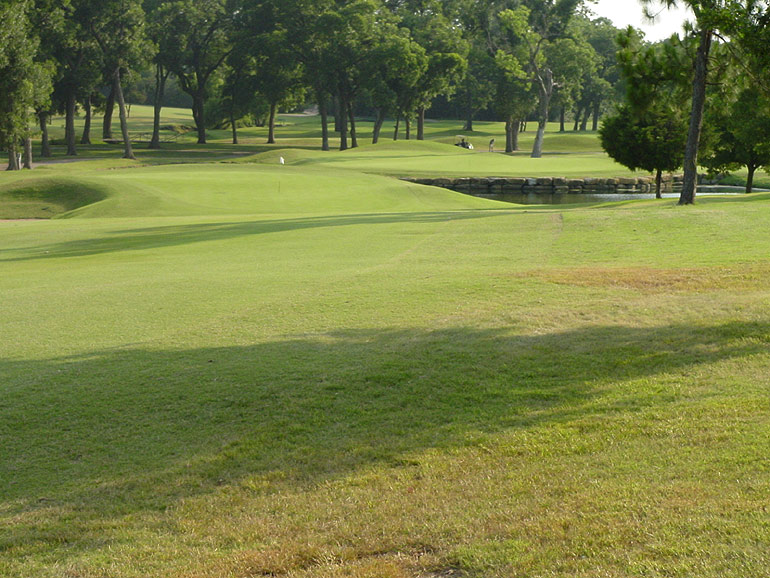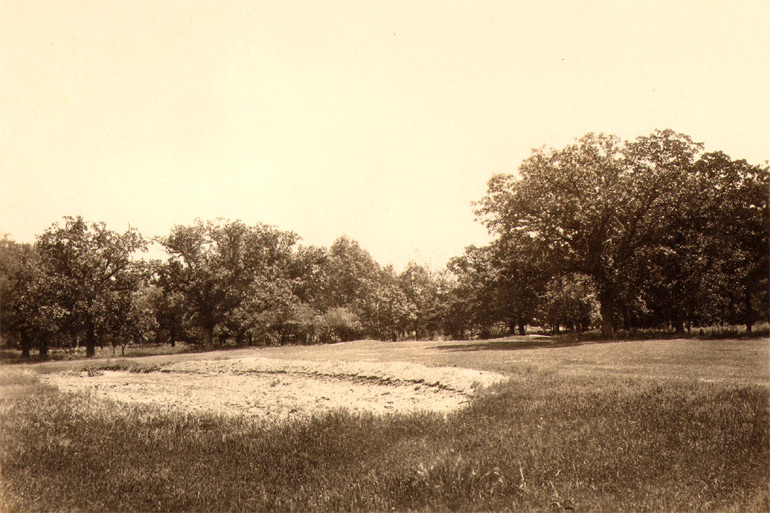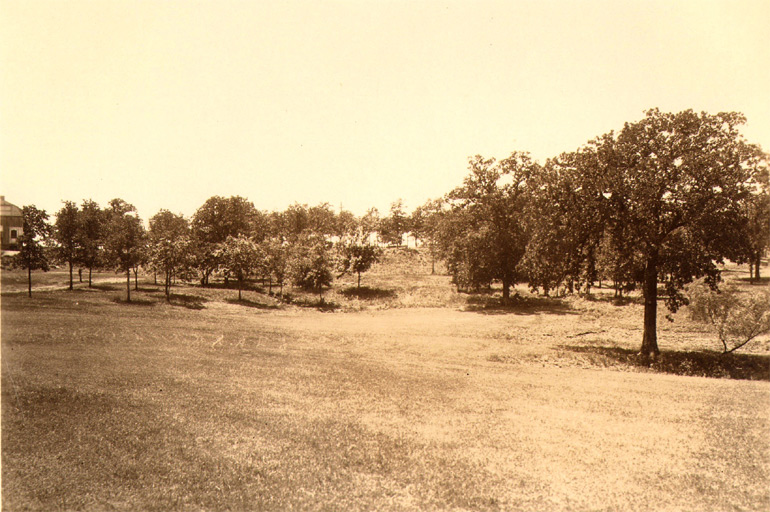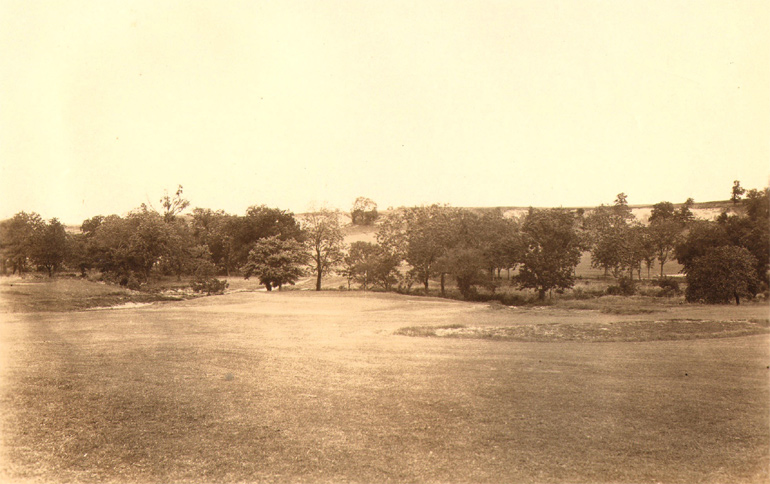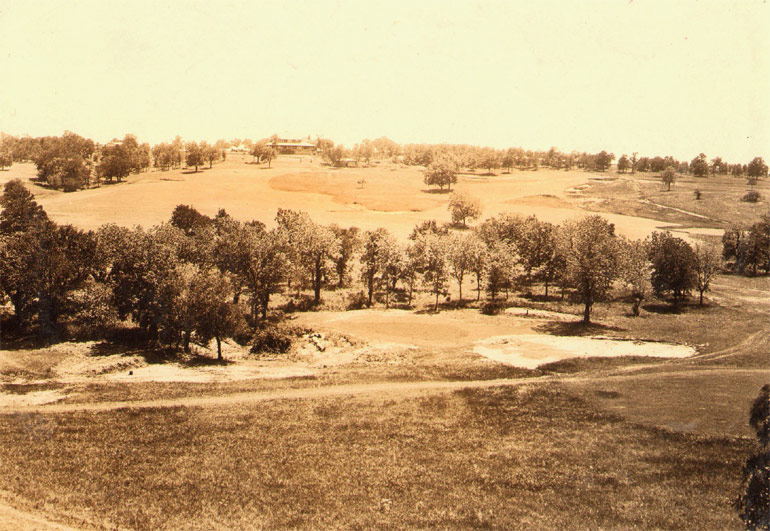Perry Maxwell’s Dornick Hills
Chris Clouser
August 2012
Dornick Hills was the first design by Perry Duke Maxwell. He tinkered with the design for over twenty years after the original course was was laid out in 1914 with four holes without bunkers. After taking a tour of golf courses in the Southeast United States, Maxwell implemented changes to the original course and created a nine-hole course which necessitated the elimination of the original fourth hole. The first nine holes resembled many of the template designs of Charles Blair Macdonald and reflected Maxwell’s further studies of the National Golf Links. After the death of his wife, Maxwell again went on another study tour to Scotland where he studied the great links courses, including St. Andrews. After returning Maxwell laid out a new nine hole design with untried design concepts that Maxwell used as his own template holes over his career.
For the first effort by Maxwell, Dornick Hills was a bold design unlike any other in the Southwest. It featured large and intimidating hazards with ample room for the less skilled player to make their way around the course. The use of grass greens and canted fairways were new to the players of the region. The use of the canted greens with Bermuda grass facilitated surface drainage and helped with the extreme Oklahoma heat. Maxwell also routed the course in and out of a valley with a natural creek and pond on the property. He also made use of the cliff on the northern edge of the property and the rise at the southern edge of the site. Maxwell routed holes to run along the edges of the rises and created tilted fairways unlike anything else seen on the flat courses of Oklahoma. Dornick Hills was a pet project to Perry with his heart and passion in the design and was a perfect exhibit of his style, even though it was his introduction to the world of golf course design.
Recently some original aerial photos of the course became available and revealed some amazing views of the golf course that previously had never been seen. This write-up goes through Dornick Hills and reveals some of the mysteries of this course that no longer exist. The cache of photos was quite an amazing find. For me it was some personal vindication as it proves several theories that I had about the course at Dornick Hills that were dispelled by many critics. Things like the number of trees that existed, the shared fairways, and the layout of several bunkers were believed by many to be a figment of my imagination. Below is a copy of the 1924 routing presented in the Oklahoma Open program that shows many of these attributes on paper. The following photographs will show that they actually existed.
The original first hole has been eliminated from the current routing due to the alterations made by Black and Nugent. The original tee was situated just above the current putting green and gave an elevated view of the first fairway with two distinct options on the tee. The player could decide to try and hit down into a valley and have a blind approach up the hill to a skyline green or lay back off of the tee and have a visible, but difficult shot into the green with a long iron. The green was protected by a lone bunker on the back side and sloped from back to front. A practice green remains today at the far end of the practice range and it can easily been seen how difficult an opening hole this was.
Maxwell added a bunker in his 1936 renovations to the front left of the green to provide further protection. One of the overlooked elements to the hole was the carry hazard that Perry placed short of the fairway. This was more than likely something that he picked after seeing several Donald Ross courses in the Southeastern United States. The first of the original photos from the recently acquired cache of images is an aerial image of most of the course with the holes identified by the lines with the hole number included. The only holes not included in the routing are the third through the sixth.
The second hole at Dornick Hills was perhaps the most beautiful of the group. It featured a diagonal tee shot over a natural pond to a green hard against the water. The bunkering by Maxwell was a generous buffer for those that were just short of the green. The difficulty of the green grew as the pin placement went further to the right. The hole was eliminated in the renovation to the front nine as the green was moved further to the left and the tee moved to create a hole that was all carry to the green over the pond. This was one of the great losses on the course. The original tee remains today with two trees between it and the green. One can easily imagine the difficulty of the hole from this angle and can also envision hitting a clear shot to the green if these trees were removed. This hole was perhaps the most used par three template by Maxwell. Many of his courses featured a par three with water running diagonally through the line of play. Some of the best examples were the 8th at Colonial, the 11th at Nichols Hills, and the 12th at Oakwood.

The above is an aerial of the second hole. The 1st green is in the foreground and the ninth fairway is running the left of the green. Note the number of trees running along the creek. Many critics of the course say that the course has too many trees in comparison to when Maxwell was there this photo adequately proves that theory wrong. The next photo is a view of the hole from the tee. The Maxwell-Woods Cemetery can be made out in the distance over the left edge of the green in the distance.
Hole Three – 425 yards
The third is a dogleg that runs at the base of a hill and provided great danger on the approach as Maxwell laid out the hole to have a fallaway green that would send approaches that were too strong into the creek behind. The green was slightly moved and the bunkering changed in the first massive redesign on the course in the 1950s. The landing zone for the drive featured a bottleneck fairway that was most accepting of a running draw to use the slight slope off of the hill. The bunkering on the hole was of little notice for those in the fairway, but was of obvious concern for those who left their approach short. Perry left the area directly in front of the green open allowing anyone to play short and bounce their approach into the green and make use of the natural flow into the putting surface.
The third hole is pictured in the photo below from just short of the narrow spot in the fairway approximately 225 yards from the green. Note the severe slope defending the left side of the green. This photo was taken just before the course was completed as the trees in the fairway were thankfully removed.
Hole Four – 190 yards
No hole at Dornick Hills is as maligned as the fourth. This is mostly due to the disdain that elevated greens on par threes receive today. But those fixated with this fail to see the wonderful feeling of anticipation as one walks up a hill to see the final results of a well-struck shot to a skyline green like this one constructed at Dornick Hills. The hole itself was originally constructed to be a simple shot up the hill to a skyline green. Those that were just short were given some relief as a bunker was eventually built into the slope to prevent balls from rolling all the way back down the hill. The green originally sloped slightly back towards the tee. Today the bunker in front has been eliminated and two traps have been added that flank the green and the green is almost two-tier in design, very much unlike Maxwell’s design.
The beauty of the Maxwell’s routing is revealed with this hole as the player was easily taken down to the lowest spot on the front nine without realizing how much they had traveled downhill from the first tee. The shot up the hill on the fourth reveals the true elevation change that has gracefully occurred on the prior three holes. Maxwell used the fourth to return to an elevated location. Below is an early photo of the fourth hole.
Hole Five – 390 yards
Maxwell was quick to adopt template holes in his career and the fifth at Dornick Hills is a prime example of one. The drive is out to a plateau with an elevated view down to the green placed perilously close to a hazard. In this case the creek runs behind the green and a swale fronted the green. So a solid pitch or short iron was necessary from the fairly flat lie. Maxwell also gave the player the option to try and cut off as much as possible with the dogleg if they were willing to deal with a precarious lie. Today there are no real options for the average player as trees protect the inside of the dogleg. But technology has made it so that today’s Herculean drives can clear all the trees and attempt to hit the green.
This was the original version of the hole that Maxwell used on several of his designs. The terrain of Oklahoma often provided the chance to use this style of hole in several routings. The hole has changed little over the years, but the photo today shows that the swale has been replaced by a lone bunker.
Hole Six – 510 yards
The only par five on the front nine holes was the sixth. Though most can attempt to reach the green in two, it would be a bold and careless move. With out of bounds on the right and a creek to the left, the need to hit the tee shot into the correct position is most important. The sixth was perhaps the most strategic hole on the course, with three different paths to the green. The player that wanted to lay back could do so, and on their second clear the waste area without much challenge but still be faced with a delicate short approach into the green. Another option was to go to the left side and play long enough that an approach to the green on the second was possible, but had to carry the creek and the swale short of the green. The last option would be to stay in the strip of fairway that ran along the side of the waste hazard. This set up a much simpler approach into the green and provided an easy shot at birdie.
The strategy of the hole provided so many different paths of attack it was a stellar design. It bore a strong resemblance to the famous Channel design used by Charles Blair Macdonald at Lido. Maxwell lacked the waterway found in the original but he had naturally occurring swales that provided similar danger. Instead of an island, he used a thin strip of land that was pinched by the hill on the right and the deep hazard on the left hand side. Anyone able to keep their ball in this region was able to attempt the carry to the green over the swale and bunker short of the green. Those that played to the wider left side of the fairway were only allowed to lay up and have a testing pitch into the steeply sloped putting surface. This was an excellent adaptation of the Channel hole concept by Maxwell in a circumstance that did not have the obvious look for such a hole. Unfortunately there were no photos of the sixth hole in the collection of Maxwell photos.
Hole Seven – 360 yards
The seventh hole was laid out at the base of the hill where the Maxwell Cemetary was placed. The drive is semi-blind over the crest of a hill with a push-up style putting surface. The best part of the hole was the wonderful hazard that was laid out around the green. The hazard was eliminated in the mid-century renovation of the course. Other than the change to the hazard, the hole is very much like what Maxwell laid out.
The slope from the crest down to the green creates a testing pitch into the green that slopes over six feet from back to front. Anyone going long has no chance of recovery due to the pond behind the green. This just makes the agony quick, but the original bunker prolonged the pain for the player as their next shot was from an unforgiving deep pit. The photo below is a modern day look at the hole.
Hole Eight – 225 yards
The difficult 8th hole has been shortened from the original length of roughly 225 yards. The bunkering and the terrain of the hole has been altered beyond recognition. The original hole was constructed as a long version of the Redan hole running from left to right. A bunker ran almost forty yards in length as a carry hazard from the tee. Maxwell designed the hole to have the ideal landing spot just beyond the furthest tip of the carry hazard. For those that didn’t want to challenge the hazards and bail out to the left, the slope of the green made many pitches difficult to stop near the hole. The difficulty of the hole was truly monumental during the era it was laid out. This was the first course that Maxwell designed the style of hole that became one of his favorites. Many similar holes were laid out throughout Oklahoma and appeared at Old Town in North Carolina. This was Maxwell’s first great par three design.
This photo is of from the Maxwell-Woods Cemetery looking over the 7th fairway and towards the 8th green.
This photo is of the 8th green from behind the diagonal bunker. Note the bump in the green that dictated the strategy of the green.
Perhaps the best remaining example of Maxwell’s design is the wonderful 9th hole. The drive is uphill to a hog’s back fairway that has severe penalties if you fall off of the fairway. Any shot to the right creates a much more difficult approach into the angled green. The wonderful green also reflects some excellent Maxwell “Rolls” that create a difficult putt from any location. This is also one of the best examples of Maxwell’s reverse-dogleg. The bunker configuration that Maxwell laid out provided a much more open front of the green. The photos below are of the ninth hole. The bunker protecting the front right of the green is still in place today.
Hole Ten – 283 yards
Maxwell perched the tee of the tenth hole on a highly elevated spot overlooking the immense rolling terrain of Primrose Hill. The view was inspiring. The player could see almost the entire site with only minor disruption from trees along the creek. The cliff on the other side of the property provided an excellent vista in the distance with the Arbuckle Mountains beyond. This was the first tee location that Maxwell ever laid out and it may have been his best (only Crystal Downs and Southern Hills compare in my mind).
The green placed short of the creek that at the base of the valley and behind a rise on the left side of the fairway that hid the target on this short par four. The width of the fairway was “immeasurable” as described in a newspaper article from the period and allowed the player to choose their preferred line from the tee. Despite this width, the fairway still contained two well-placed hazards. Perry placed a carry bunker on the left hand side to protect the best angle into the push-up green complex. The player that attempted this route was rewarded with a much easier approach to a green. Maxwell placed the other bunker into the face of a slight rise fifty yards short of the green. The player that stayed to the safe side was given a testing approach into the green and had to deal with the hazards around the green. There was a bunker that ran completely around the green complex. The putting surface was somewhat flat but did have a slight slope from front to back with rolls in it that resembled waves.
The green was moved by Maxwell in 1936 to the other side of the creek. This move was made after watching players compete at the 1935 PGA Championship in Oklahoma City at his own Twin Hills. He felt this would increase the difficulty of the course for the top players of the era. The current green was later rebuilt to the left of that location by Jeff Brauer. The hole was the first template that Maxwell ever laid out. Below is a photo of the original greensite. Notice how the green narrows the deeper you get into it and the hazard about 50 yards short of the green.
Below is a copy of a photo after the green was moved by Maxwell in 1936.

This photo shows the hole from just in front of the tee. The building in the distance is the old Gun and Rod Club Building. The Gun and Rod Club is still adjacent to the Dornick Hills property.

Hole Eleven – 400 yards
The original second hole and current eleventh was much more strategic in nature than its current version. The best approach to the green was from the left side, which was protected by the large bunker that separated the original first and second holes. Also adding to the challenge of getting to the preferred landing zone were two ridges that forced the terrain in opposite directions. Landing between the ridges was the key to having a shot into the green and avoid the bunkers on the right side of the hole. The bunkers ran along all the way to the putting surface in a stair-step manner. The original bunkers would have been grass bunkers. Early photos of the course do not show sand bunkers from the tee. They were later converted to sand by Maxwell. The player had to hit an uphill approach shot to the green perched precariously atop the knoll. The lesser player was given the chance to lay up, as the area below the putting surface was completely open. The second featured a larger green than the current version: it was almost twice the current size but it sloped considerably more from back to front. The current green is located just left of the original putting surface.
This may be my favorite photo of the entire collection. This photo was taken from the area of the cliff near the Maxwell-Woods cemetery and is proof that at one time most of the course was visible from the location.
Hole Twelve – 420 yards
With the design of the twelfth hole on his course, Maxwell again went back to his study of the National Golf Links. This time he built a replica of the famous bottle hole. Perry’s version was somewhat tame in comparison to the Macdonald beauty, but it had all the key elements. There were two distinct fairways, with the one having the preferred angle on a slightly lower level than the other. The player could use the terrain to get the ball to this lower level on the right or carry it over two bunkers on that side. The deterrent on the left side of the fairway was a tree fifty yards short of the green.
The green was also protected by a swale short of the green and had a false front much like Macdonald’s version. For those who went right of the green, there was a vast waste bunker that made saving par difficult, as the green sloped away from the hazard. The preferred line into the green was made much simpler when Maxwell moved the tee boxes forward in 1936. The tee boxes were also lowered and this created a semi-blind tee shot. This, along with the lack of an irrigation system probably led to the eventual demise of the double fairway.
Some have speculated that this was originally a bunker, but this photo proves that Maxwell used a tree. This was the first indication of the impact Maxwell thought trees could have in the design of his holes. It is also the first hole that Maxwell laid out with a canted fairway.
Hole Thirteen – 445 yards
With the first expansion of Dornick Hills, Maxwell created his own version of the Road Hole on the long par four thirteenth that featured a tee shot out to the fairway from the same tee location but along the western boundary of the property. The fairway on this hole was shared with the fifteenth and sixteenth holes and was actually split by small hills and bumps created by Maxwell during the construction of the holes. The approach was very difficult as the left side of the green was protected by a deep pot bunker and the right side was protected by two long bunkers that were created to symbolize the famous Road at St. Andrews. The green was also well-defended as the slope of the green ran almost six feet from back to front and three significant tiers.
The natural slope of the land in this case was used in this case to help the player place their tee shot on the correct side of the fairway. The narrow opening to the green was best attacked from the right side of the fairway and the player that shaped their shot accordingly had the best chance of staying on this half of the landing zone. But the player that hit an inaccurate approach would be penalized heavily as all the remaining hazards were along the right side, with the exception of the pot bunker short and the bunker placed directly behind.
The shortest par four followed the longest and was a great hole amply protected by deep hazards short of the green and a steeply sloping green. It gives the longer player a true advantage, but they must execute their shot perfectly or they will be in a worse position than the player that lays up in the fairway. This was Maxwell’s version of the “Knoll” hole where he had deep hazards short of the green perched on a rise.
Width was the key component of the hole as the fairway was almost forty strides across. The deep bunkers in the face of the hill were a force to be reckoned with if any approaches lack the strength to go up the hill. The best angle into the green was from the right side as the player would also be able to hit into the slope of the green and possibly stop their shot before going beyond the hole and be faced with a difficult downhill putt. The steep putting surface was altered in the renovations by Jeff Brauer.
Photo of the 14th green from atop the cliff.

Hole Fifteen – 400 yards
By this point in the routing the player was put onto the dominant feature of the southern edge of the property, the cliff. A steep forty foot drop provided a dramatic elevated tee on the fifteenth hole. Another prototype hole for Perry Maxwell was the fallaway hole which featured a green that sloped significantly from front to back and away from the player. The 15th was such a hole. The large shared fairway was pinched by bunkers on the left side. The approach to the green was what would truly test the mettle of any player. Short of the green was a swale on the right side accompanied by a mound on that side. This mound provided the dominant slope of the green away from the player.
Aerial photo with the 15th hole in the middle with the 13th to the left, the 12th green in the bottom corner and the 16th running back out to the cliff.

This photo is an early photo of the 15th green. This may have been prior to Maxwell adding bunkers to the design. Note the automobile on the road in the distance. That road is now Route 77.
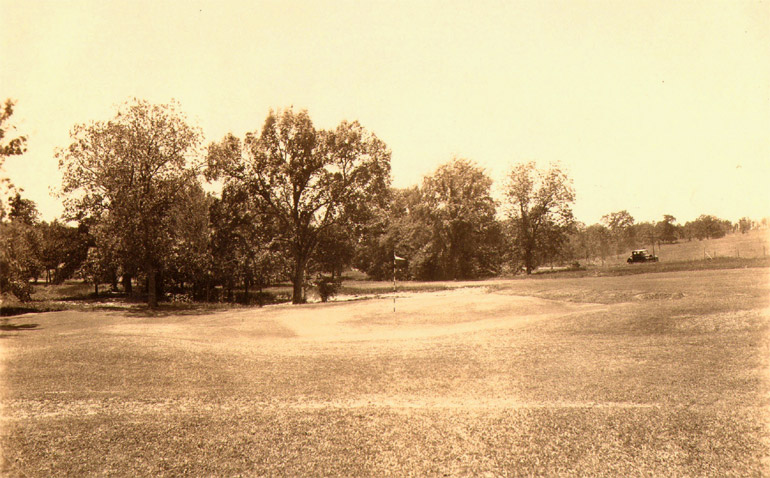
Hole Sixteen – 530 yards
The sixteenth hole, the most famous at Dornick Hills, is known as “The Cliff.” This hole more than any other signifies what Perry Maxwell designs were all about: using the natural features of the land to make a golf course. The hole is further testimony to Perry’s belief in the conceptual copy theory of Macdonald. Most players would object to a modern hole like this because they wouldn’t have the opportunity to get home in two shots, or that the granite wall was an eyesore. That would be our loss, as this is one of the truly great par-five holes by Maxwell. The hole plays at 532 yards from the tips, and the green can only be reached in two with a tailwind. The rough and trees to the right are the primary danger, but the key to this hole is where you put your second shot. The green sits atop a forty-foot cliff and is extremely difficult to hold. It was also one of the more insidious on the course: it featured three mounds and ridges that dominated the contours of the green, making putting an adventure if the player ended up in the wrong portion of the green. There is no safe spot if you need to bail out on the approach, as out of bounds is behind and to the left, and short is the rock face.
The original hole layout featured bunkering that added interest to the hole. This bunkering forced a player to make a decision on the second shot. If they laid up short of the bunkers they had a long approach into the narrow green. If they tried to get close to the green, they would have a delicate touch to stay on the green. Maxwell also presented another option with the shared fairway to the left side. From one side to the other this portion of the fairway was almost eighty yards wide. Not only was this hole natural in appearance, it presented the player with multiple options due to the width of the fairway and the excellent use of hazards. Maxwell also laid out many ripples in the terrain to create uneven lies.
This photo of the 16th shows the immense width of the fairway and the large green.

This photo is from the base of the cliff. Obviously the photographer was a little off balance.

Hole Seventeen – 150 yards
The last one-shot hole, the 17th, was the only one on the original nine. The elevated tee called for the player to hit a shot into the Oklahoma winds and play against the prevailing breeze. It also required the player to navigate the hazards, including the deep pit to the left side of the green. The pit was about six feet in depth. The green was a smaller version of the “Short Hole” green found at National Golf Links and had very clear undulations that split the green into three distinct portions. The hole has been severely altered overtime with the most recent changes being a reconstruction of the green and the elimination of the bunkers on the left side with a retention pond.
The green and bunker complex was the basis for one of Maxwell’s most used templates. There were several versions used throughout his career. The bunker complex was similar to what he would later do throughout his career. Instead of having the one long bunker on the left side he would split it into two hazards and add one more to the right, thus surrounding the putting surface. Other versions of the hole are found in the form of the second at Prairie Dunes and the second at the Old Town Club.
This view of the 17th in its original form with the 18th, 10th, and 11th holes in the background across the creek.
The typical Maxwell finishing hole is an uphill par four. Dornick Hills was the first of these. The tee shot is the most difficult part of the hole. It runs dramatically uphill to a stair-stepping fairway. The fairway in the original design, shared the fairway with the tenth hole, contained a noticeable hazard in the original design. This was later removed and the fairway extended further up the right side of the hole. Anyone who strayed too far to the right side would roll down the banking into the tenth fairway and have a much more difficult approach from a lie with the ball below their feet. The left side of the fairway was a challenge to reach from the tee, as a large hazard protected that side and unless you reached the flat portion of the fairway an awkward lie awaited. The green was was protected on the left side by two bunkers, large, and sloped steeply from back to front. The most difficult pin position was the one tucked behind the bunker protecting the front of the green.

Unfortunately, there were no photos of the holes five, six, and thirteen in the collection. Based on the accuracy of the photos from the other holes, the drawings attached for those holes should provide a great idea of how those holes appeared at the time. The lack of a photo for the sixth hole is a personal disappointment. In closing, this set of photos provide great insight as to what the course looked like in Maxwell’s day. I hope this group of photos also gives you some thought of how great the course at Dornick Hills was in its day. It was the first course in the state of Oklahoma to have grass greens and was easily the best design at the time. It also set in motion a series of steps that would eventually lead to a career that was recently recognized by the Jim Thorpe Association and Oklahoma Sports Hall of Fame as worthy of induction for the man known to his friends as PD.
THE END



